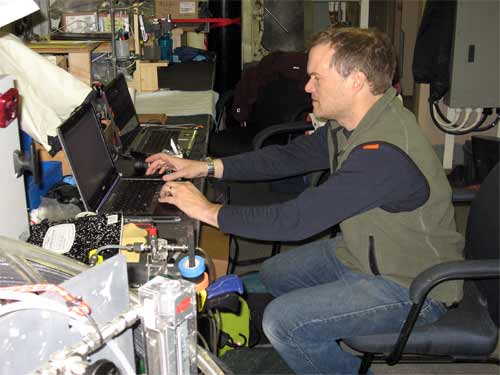To understand the multi-core I need to step back a bit. Let's say we understand a food web, you know one species eating another all intricately linked through their dependence upon each other. Well if you were to start at the bottom of the ocean you would see different nutrients at different depths with different critters eating different critters, and what you might not know is that what is in the sediments at the bottom of the ocean plays a huge role in what is available to eat and when for many other species.
 The Multi-Core has just finished a station, we now have eight fresh sediment samples for testing.
The Multi-Core has just finished a station, we now have eight fresh sediment samples for testing.
David Shull with his team are working on a four year NSF grant, hoping to prove a few hypotheses involving the sediments of the Eastern Bering Sea Shelf.
TWO SUPPOSITIONS: -Benthos (deep animals) who live in the sediments affect nutrient cycling in the Bering Sea. -Changes in the organic matter supply on the sea floor affect benthic organisms.
NOW THE QUESTION: Can change due to ice cover affect the nutrient cycling and ecology of the Bering Sea?
 After the sediments are collected the hard work begins while the team collects data.
After the sediments are collected the hard work begins while the team collects data.
Compared to other oceanic ecosystems the Bering Sea is shallow, which affects when organic matter hits the bottom, and when the benthic community consumes it. By using the Multi-Core to sample sediments the scientists are able to test for different elements and compounds to assess the health of these ocean communities. The scientists then make hypotheses on changes to these ecosystems due to the possible shifting ice patterns on the surface.
 By compressing the core Heather is able to get relative pore size information based on the water she is able to remove from the sediment.
By compressing the core Heather is able to get relative pore size information based on the water she is able to remove from the sediment.
The Multi-Core team completes approximately five different experiments from the samples they collect: -Some of the core material is preserved for species specimen collection -A centrifuge is used to look for nutrients in the Sediments -Some core material is incubated to measure the rate of change in the nutrients found in the water. -The sediments are probed for oxygen. -The team squeezes the sample for pore water analysis.
Whew, I'm out of breath and hope that I have been able to explain this in a way that clarifies what the scientists are doing. I understand the need for this information, but am still learning how all the data that the team collects can support their original hypothesis.
Aren't you a bit curious about ecological changes due to shifting ice patterns over the Eastern Bering Sea Shelf? And I guess the big question for me is, how do I emphasize to readers that what changes in one ecosystem on this planet has the potential to affect all ecosystems of the planet!
Greg is tired
 Three thirty in the morning is just late for anyone! Greg will have to get up within the hour to work for another three+ hours once the newest samples are brought on board.
Three thirty in the morning is just late for anyone! Greg will have to get up within the hour to work for another three+ hours once the newest samples are brought on board.
Three thirty in the morning is just late for anyone! Greg will have to get up within the hour to work for another three+ hours once the newest samples are brought on board.
 On July fourth the crew and scientists were very happy for a wonderful barbecue. Andy Yeckley, BM3 who works within the Deck department grilled us a super meal! Thanks Andy!
On July fourth the crew and scientists were very happy for a wonderful barbecue. Andy Yeckley, BM3 who works within the Deck department grilled us a super meal! Thanks Andy!
Quote of the Day: Now I see the secret of the making of the best persons, it is to grow in the open air, and to eat and sleep with the earth. -Walt Whitman
FOR MY STUDENTS: Is anyone out there?

